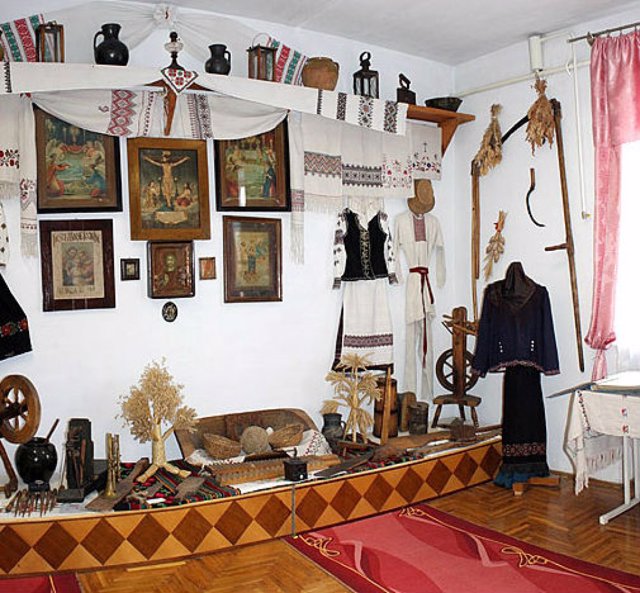Functional temporarily unavailable
General information about Radekhiv
The city of Radekhiv is located 65 km north-east of Lviv, towards Lutsk. It was first mentioned in documents in 1474, although it already existed in the 10th century. The name comes from the name of the founder - Radekh (Radek). The location of Radekhov at the intersection of two important trade routes - from Lvov to Lutsk and from Sokal to Kremenets - contributed to both economic development and the frequent raids of the Tatars. Until the 18th century. the city belonged to the noblemen Laschas, and in 1720 passed into the possession of the counts of Mirov, who built a palace in the style of classicism and a church. In 1752 the city received the Magdeburg Law. In 1874, the Radekhov estate became the property of Count S. Badeni, brother of the Austrian governor of Galicia K. Badeni, who ...
The city of Radekhiv is located 65 km north-east of Lviv, towards Lutsk. It was first mentioned in documents in 1474, although it already existed in the 10th century. The name comes from the name of the founder - Radekh (Radek). The location of Radekhov at the intersection of two important trade routes - from Lvov to Lutsk and from Sokal to Kremenets - contributed to both economic development and the frequent raids of the Tatars. Until the 18th century. the city belonged to the noblemen Laschas, and in 1720 passed into the possession of the counts of Mirov, who built a palace in the style of classicism and a church. In 1752 the city received the Magdeburg Law. In 1874, the Radekhov estate became the property of Count S. Badeni, brother of the Austrian governor of Galicia K. Badeni, who married the daughter of Count Mira Cecilia. Count Badeni rebuilt the palace, laid out a park, built a greenhouse and surrounded the palace and park complex with a fence. On the territory of the park, a fragment of the fence, the skeleton of the greenhouse and an outbuilding have been preserved. Now the most notable building of Radekhov is the People's House, erected in 1912. The Nicholas Church (1918) is also preserved.
Місто Радехів розташоване в 65 км на північний схід від Львова, в напрямку до Луцька. В документах вперше згадується в 1474 році, хоча існувало вже в X ст. Назва походить від імені засновника - Радеха (Радека). Розташування Радехова на перетині двох важливих торгових шляхів - зі Львова до Луцька і з Сокаля в Кременець - сприяло як економічному розвитку, так і частим набігам татар. До XVIII ст. місто належало шляхтичам Лащам, а в 1720 році перейшло у володіння графів Мірів, які побудували палац в стилі класицизму і костел. В 1752 році місто отримало Магдебурзьке право. В 1874 році радехівський маєток став власністю графа С. Бадені, брата австрійського намісника Галичини К. Бадені, який одружився на дочці графа Міра Сесілії. Граф Бадені перебудував палац, розбив парк, побудував оранжерею ...
Місто Радехів розташоване в 65 км на північний схід від Львова, в напрямку до Луцька. В документах вперше згадується в 1474 році, хоча існувало вже в X ст. Назва походить від імені засновника - Радеха (Радека). Розташування Радехова на перетині двох важливих торгових шляхів - зі Львова до Луцька і з Сокаля в Кременець - сприяло як економічному розвитку, так і частим набігам татар. До XVIII ст. місто належало шляхтичам Лащам, а в 1720 році перейшло у володіння графів Мірів, які побудували палац в стилі класицизму і костел. В 1752 році місто отримало Магдебурзьке право. В 1874 році радехівський маєток став власністю графа С. Бадені, брата австрійського намісника Галичини К. Бадені, який одружився на дочці графа Міра Сесілії. Граф Бадені перебудував палац, розбив парк, побудував оранжерею й оточив палацово-парковий комплекс огорожею. На території парку зберігся фрагмент огорожі, остов оранжереї та господарське приміщення. Зараз найпомітнішою будівлею Радехова є Народний дім, зведений в 1912 році. Також збереглася Миколаївська церква (1918 р.).
Сплануй своє перебування у Radekhiv
What to see and where to go in Radekhiv
Tourist attractions and museums of Radekhiv

Radekhiv Museum of Local Lore
Museum / gallery
The Radekhiv Museum of History and Local Lore began its work in 2004 in an old villa in the center of Radekhiv. More than 1,500 exhibits are housed in six halls. The exposition is divided into several sections: "On the history of the Ukrainian state", "Archaeological monuments and ethnography of the region", "Education and history of school Radekhiv region", "Flora and fauna of the region", "Outstanding people of Radekhiv region", "National liberation struggle in Radekhiv region ". Each room in the museum recreates the family and social life of the region. Interesting is the interior of a peasant house with clothes, samples of pottery, antique coins, tools, a model of hiding and a corner of I. Bilozir.
Reviews Radekhiv
Geographical information about Radekhiv
| {{itemKey}} | {{itemValue}} |
|---|---|
| Region |
Lviv |


